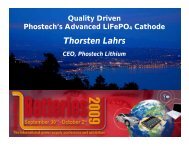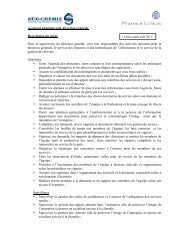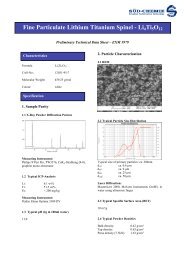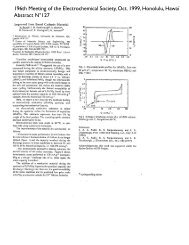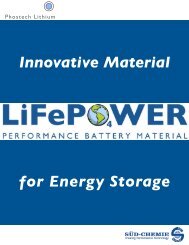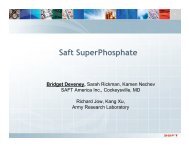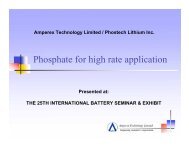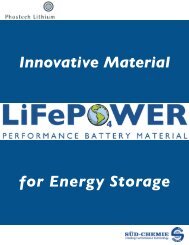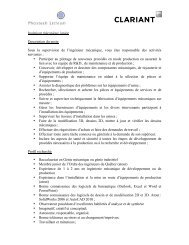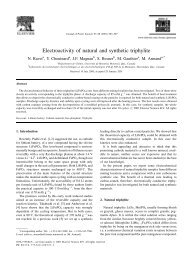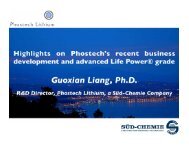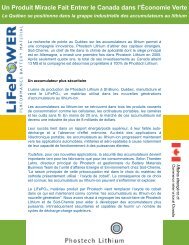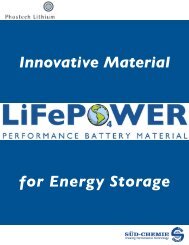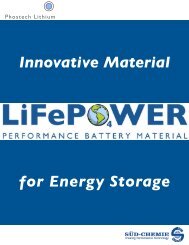Complexity of Battery Grade C-LiFePO4 Development and
Complexity of Battery Grade C-LiFePO4 Development and
Complexity of Battery Grade C-LiFePO4 Development and
Create successful ePaper yourself
Turn your PDF publications into a flip-book with our unique Google optimized e-Paper software.
<strong>Complexity</strong> <strong>of</strong> <strong>Battery</strong> <strong>Grade</strong> C-<strong>LiFePO4</strong><br />
<strong>Development</strong> <strong>and</strong> Quality Management<br />
Thorsten Lahrs<br />
CEO, Phostech Lithium<br />
THE 27 th INTERNATIONAL BATTERY SEMINAR & EXHIBIT<br />
Primary & Secondary Batteries - Other Technologie<br />
March 15 - 18, 2010<br />
Broward County Convention Center<br />
Fort Lauderdale, Florida
Pyrolytic Carbon Deposit (PCD)<br />
Pyrolysis <strong>of</strong> most organic<br />
materials during or after<br />
<strong>LiFePO4</strong> synthesis leaves a<br />
conductive C deposit.<br />
Organic precursor can be<br />
solid, liquid or gas.<br />
Carbon deposit is bonded on<br />
elementary particles or on<br />
agglomerates = C-<strong>LiFePO4</strong><br />
PCD controls sintering <strong>and</strong> helps<br />
preserve Fe precursor or <strong>LiFePO4</strong><br />
size & shape, e.g. 50nm to 15µ.<br />
<strong>LiFePO4</strong><br />
200 nm 100 nm<br />
2 µ agglomerate<br />
Carbon<br />
deposit<br />
Key to material power, optimal energy <strong>and</strong> cyclability
Phostech Production Processes<br />
Process Solid State Wet Process Melt<br />
<strong>Grade</strong> Energy Power Alternative<br />
Status Commercial P1 Commercial P2<br />
<br />
Pilot<br />
Scale<br />
Phostech Lithium controls several synthesis processes to<br />
fulfill needs <strong>of</strong> present & future customers <strong>and</strong> markets
Phostech Commercial Products<br />
P2 - Power <strong>Grade</strong><br />
P1 - Energy <strong>Grade</strong><br />
Nanosized Micro-Aggregates<br />
+ Under-development products to fulfill customers needs<br />
Strong R&D investment to continuously improved products
<strong>LiFePO4</strong> Production Capabilities<br />
500 tons/year<br />
Life Power® P1 in Québec<br />
250 tons/year<br />
Life Power® P2 in Germany<br />
Capacity expansion planned
<strong>LiFePO4</strong> Market Main Advantages<br />
Phostech Lithium introduced <strong>LiFePO4</strong><br />
on market with a specific br<strong>and</strong> name:<br />
Life Power®<br />
•Significantly more stable <strong>and</strong> therefore<br />
safer than conventional cathode materials<br />
•More cost-effective as no very rare <strong>and</strong><br />
expensive cobalt<br />
•High-power & Fast-charge capabilities<br />
•Wide temperature tolerance ensuring<br />
performance at -40°C<br />
Life Power® quality recognized by battery industry
Life Power® P1 Solid State Process<br />
FePO4 + ½ Li2CO3 + C-precursor C-<strong>LiFePO4</strong><br />
+<br />
-<br />
•Simple: mixing + heating<br />
•Low cost equipment (furnace)<br />
•One-step reaction<br />
•Depends on Fe 3+ ion-diffusion<br />
•Depends on solid reactants mixing quality<br />
•Non-reversible side reaction<br />
•Cost <strong>of</strong> precursors (FePO4)<br />
Energy grade C-<strong>LiFePO4</strong><br />
=> Improved power grade in development
+<br />
-<br />
Life Power® P2 Wet Process<br />
Fe source + Li source + P source <strong>LiFePO4</strong><br />
<strong>LiFePO4</strong> + C-precursor C-<strong>LiFePO4</strong><br />
•Low cost reactants<br />
•Complete reaction in liquid phase<br />
•Q/C & chemical purity control at each step<br />
•Particle size, morphology <strong>and</strong> purity control by precipitation<br />
•Consistency => low rejects <strong>and</strong> narrow cells specifications<br />
•Nano-sized primary particles for power applications<br />
•Capital intensive manufacturing process<br />
•Require large scale installations<br />
Power grade C-<strong>LiFePO4</strong><br />
=> Improved energy grade in development
Ragone plot <strong>of</strong> Life Power® cells<br />
Life Power® P1<br />
Life Power® P2<br />
K2 Energy Solution - www.k2es.com
K2 Energy Solutions new 12V 6.4 & 9.6 Ah batteries<br />
•Designed for medical, military, industrial fields<br />
+ consumer applications<br />
K2B12V7<br />
K2B12V10<br />
Backward compatible with lead acid batteries !
Uncompromised quality key to success<br />
Source: SAFT 11th Electrochemical Power Sources R&D Symposium (July 2009)<br />
Minimal impedance growth !
How does LiFe Power® LFP compare to NCA ?<br />
Capacity (Ah)<br />
10<br />
8<br />
6<br />
4<br />
2<br />
0<br />
NCA 100% DOD<br />
NCA 80% DOD<br />
LiFePO 4 100% DOD<br />
"If one want to achieve the same life cycle as<br />
LFP, DOD have to be reduced to 80% for NCA,<br />
which nearly compensates for the energy density<br />
gap between both chemistries on cell level"<br />
0 500 1000 1500 2000<br />
Cycles<br />
Any hesitation for your HEV batteries ?
H2O uptake (ppm)<br />
C-<strong>LiFePO4</strong> <strong>and</strong> its relationship to humidity ...<br />
700<br />
600<br />
500<br />
400<br />
300<br />
200<br />
100<br />
0<br />
0 500 1000 1500 2000<br />
time (second)<br />
But leads to irreversible<br />
chemical degradation<br />
=><br />
=> C-<strong>LiFePO4</strong> likes water !<br />
Capacity (mAh/g)<br />
148<br />
147<br />
146<br />
145<br />
144<br />
143<br />
142<br />
141<br />
Fresh synthesis<br />
1 week aging<br />
at atmosphere<br />
T = 60°C<br />
0 10 20 30<br />
Cycle<br />
40 50<br />
Phostech’s R&D/QC has sensibilized early its customers, allowing them to<br />
introduce suitable technological solution in their battery production line
Capacity (mAh/g)<br />
160<br />
155<br />
150<br />
145<br />
140<br />
135<br />
Activation effect for Life Power® P1<br />
130<br />
60°C<br />
activation<br />
Li/LiPF6 EC-DEC/C-<strong>LiFePO4</strong><br />
1 st C/D cycle at 60°C - C/8<br />
2 nd C/D cycle at 60°C - C/8<br />
Cycle<br />
Cycling at 25°C - C/12<br />
0 5 10 15 20 25<br />
Activation suppressed after 60°C cycle !!!
Also positive effect for irreversible capacity ...<br />
Potential (Volt vs. Li + /Li 0 )<br />
4,0<br />
3,5<br />
3,0<br />
2,5<br />
2,0<br />
Li/LiPF6 EC-DEC/C-<strong>LiFePO4</strong><br />
1st 1<br />
C/D cycle at 60°C - C/8<br />
st C/D cycle at 25°C - C/12<br />
2 nd C/D cycle at 25°C - C/12<br />
(after 1 st C/D cycle at 60°C - C/8)<br />
0 50 100 150 200<br />
Capacity (mAh/g)<br />
60°C cycle could improve battery performance
Optimization through P1 & P2 mixture<br />
Easier to process than pure P2<br />
Better power than pure P1<br />
Improved packing density/energy density<br />
Excellent cycling stability<br />
Lower resistance<br />
P1/P2 mixture is<br />
a simple solution<br />
Best <strong>of</strong> both world solution !
Phostech investment in quality<br />
St-Bruno dry room dedicated to QC
Phostech investment in quality<br />
St-Bruno QC cycling facility <strong>and</strong> laboratory
Automotive QC requirements<br />
Exemple: Life Power® P2 Stoichiometry (at.%) QC<br />
190 consecutive lots including <strong>of</strong>f-spec<br />
Automotive requirements with > 25 parameters to control !!!<br />
Huge QC investments to enter automotive market
Phostech C-<strong>LiFePO4</strong> is used <strong>and</strong> evaluated by<br />
numerous companies (PT, HEV, PHEV, EV, UPS...)<br />
Phostech Lithium<br />
US<br />
Interim Report 2007<br />
Süd-Chemie Group continues successful<br />
performance <strong>and</strong> exceeds expectations<br />
– Revenue increased 14% compared<br />
with first half <strong>of</strong> 2006<br />
- – ebit rose 64% compared with first half <strong>of</strong> 2006<br />
- – Significant upturn in forecast for the full year<br />
Europe<br />
High Energy Large Prismatic Rechargeable Cell<br />
Lithium Nickel Cobalt Manganese (NiCoMax)<br />
China<br />
Others customers disclosed in the coming months ...<br />
World Class. American Made.<br />
Japan<br />
International <strong>Battery</strong>, Inc.’s Lithium Nickel Cobalt Manganese<br />
rechargeable cells are available in a rugged prismatic format in<br />
capacities ranging from 50 - 200Ah. The thermal stability <strong>and</strong> safety<br />
Korea<br />
performance <strong>of</strong> the NiCoMax electrochemical system is superior<br />
�����������������������������������������������������������������<br />
������������������������������������������������������������������<br />
packaging. IB’s cells <strong>of</strong>fer a low self-discharge rate <strong>and</strong> have excellent<br />
operating temperature characteristics. The excellent thermal stability<br />
<strong>and</strong> safety performance <strong>of</strong> the NiCoMax electrochemical system is well<br />
suited for variety <strong>of</strong> commercial, military <strong>and</strong> industrial applications.<br />
Features: �����������������������������������������<br />
Applications: �����������������������������������������������������������<br />
applications, communications, backup power, energy<br />
storage (wind, solar, tidal).<br />
NiCoMox Packaged Cells<br />
������������ Condition IB-B-CHE-50 IB-B-CHE-90 IB-B-CHE-200<br />
Nominal Voltage (C/3) 3.7 Volts 3.7 Volts 3.7 Volts<br />
Nominal Capacity (C/3) 50 Ah 90 Ah 200 Ah<br />
�������������� (C/3) 185 Wh 333 Wh 740 Wh<br />
�������������� (C/3) 123 Wh/Kg 135 Wh/Kg 133 Wh/Kg<br />
Peak Power (60% DOD) 30 sec, 2/3 OCV, 60% 675 W (450 W/Kg) 1300 W (517 W/Kg) 3000 W (540 W/Kg)
Multicore "Material" Intellectual Property<br />
1 2 3<br />
Ca<br />
de<br />
Core 1: <strong>LiFePO4</strong> (HQ/UT)<br />
US 5,910,382 C1 US 6,514,640 C1<br />
CA 2,251,709 EP 0904607<br />
Core 2: Carbon deposit 1<br />
(ACEP, UdM, CNRS co-ownership)<br />
US 6,962,666 US 7,344,659<br />
EP 1049182 EP 1796189<br />
CA 2,307,119<br />
+ JP examination<br />
Core 3: Carbon deposit 2<br />
(HQ, UdM, CNRS co-ownership)<br />
Necessary "free to operate" <strong>LiFePO4</strong> material IP<br />
2 nm<br />
US 7,457,018<br />
KR 100879839<br />
CN 100421289<br />
+ JP, EP <strong>and</strong> CA examination
Phostech’s improved solid-state C-<strong>LiFePO4</strong><br />
Capacity (mAh/g)<br />
180<br />
160<br />
140<br />
120<br />
100<br />
80<br />
60<br />
40<br />
20<br />
0<br />
0<br />
C/10<br />
157 mAh/g<br />
C<br />
136 mAh/g<br />
10C<br />
90 mAh/g<br />
0,1 1 10 100<br />
C-Rate<br />
Performance still improved, sampling in 4Q 2010
Thank you for your attention !<br />
See you next time in Cannes !<br />
For more<br />
information:<br />
info@phostechlithium.com<br />
www.phostechlithium.com



